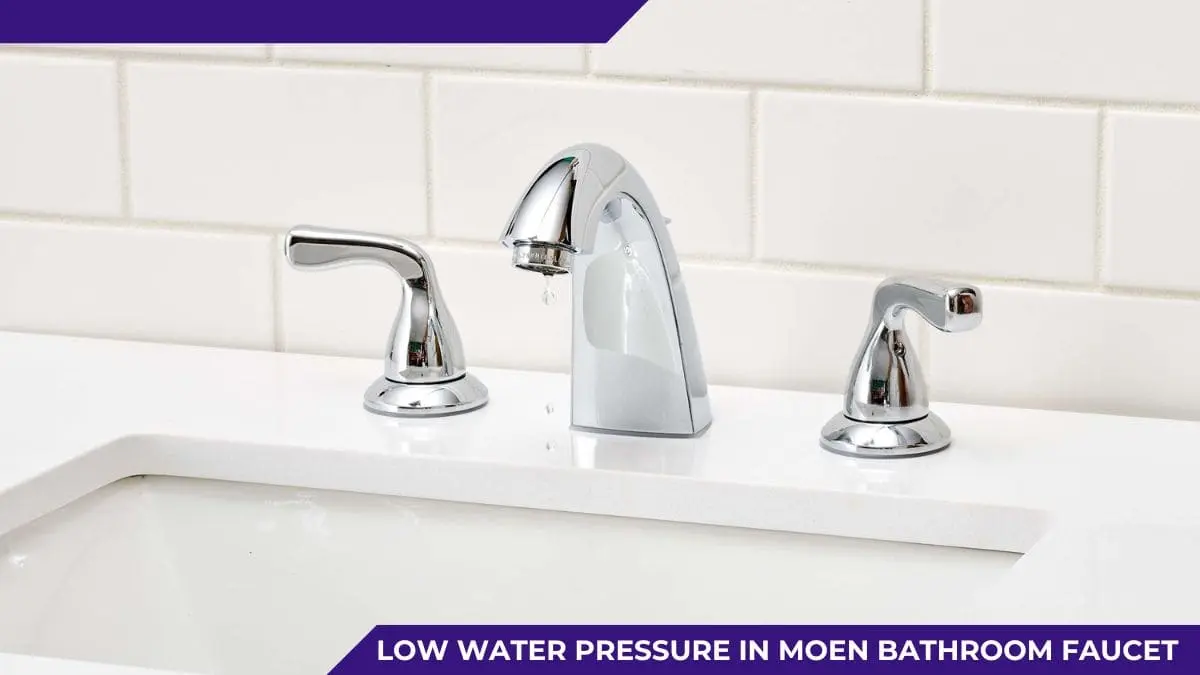Low water pressure in your Moen bathroom faucet can be frustrating, especially when it interrupts daily routines like washing your hands or brushing your teeth. Low water pressure is often a sign of underlying issues that can vary in complexity, from a simple aerator clog to more serious problems with the faucet’s cartridge or your home’s plumbing system.
In this article, we will explore the common causes of low water pressure in Moen bathroom faucets, provide troubleshooting tips, and offer step-by-step solutions to help restore normal flow. Whether you’re a DIY homeowner or considering hiring a plumber, this guide will equip you with the knowledge you need to fix the issue and maintain your faucet for optimal performance.
Common Reasons Behind Low Water Pressure in Moen Bathroom Faucets
Low water pressure in Moen bathroom faucets is often caused by several factors that can hinder the normal flow of water. Understanding these causes can help homeowners quickly diagnose the issue and take appropriate action. Here are the most common reasons behind low water pressure in Moen faucets.
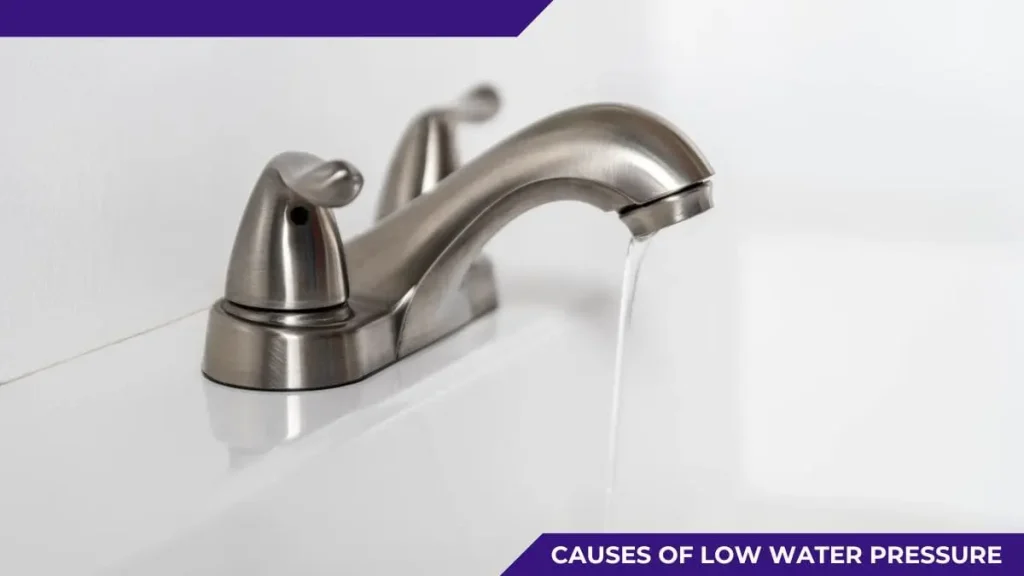
Blocked Aerator
One of the most common causes of low water pressure in a Moen bathroom faucet is a blocked aerator. The aerator is a small mesh screen located at the tip of the faucet. It mixes air with water, creating a steady flow while also conserving water. Over time, mineral deposits from hard water can accumulate on the aerator, restricting the water flow and causing pressure to drop. Regularly cleaning the aerator can prevent blockages and maintain normal water pressure. If you notice water sputtering or a weakened stream, the aerator is likely the culprit.
Clogged Cartridge
Another frequent cause of low water pressure in Moen bathroom faucets is a clogged cartridge. The cartridge is responsible for controlling the flow of water when you turn the handle. Over time, debris, sediment, or mineral buildup can accumulate within the cartridge, obstructing water flow and reducing pressure. A clogged cartridge may require cleaning or replacement to restore proper water pressure. If you experience inconsistent water flow or the faucet seems difficult to operate, the cartridge is often the issue.
Water Supply Issues
Sometimes, the problem lies not within the faucet but in the home’s water supply. Low water pressure can result from issues with the main water supply or supply lines connected to the faucet. If multiple faucets in your home are experiencing low water pressure, it may be a sign of a larger problem, such as a leak or blockage in the supply pipes. Additionally, municipal water supply disruptions or maintenance work can temporarily affect the water pressure in your home.
Valve Partially Closed
The shut-off valve beneath the sink controls the water supply to your faucet. If this valve is not fully open, it can reduce the amount of water flowing to the faucet, leading to low pressure. This is a simple but often overlooked cause of low water pressure. Checking that the valve is fully open is a quick troubleshooting step that can solve the issue in seconds.
Leaks in Plumbing
Leaks in the plumbing system, whether in the faucet itself or the pipes supplying it, can also result in low water pressure. A small leak reduces the amount of water reaching the faucet, causing a noticeable pressure drop. Leaks may not always be visible, especially if they occur behind walls or under sinks. If the water pressure continues to drop despite other troubleshooting efforts, it may be necessary to inspect the plumbing for leaks or consult a professional plumber to identify hidden issues.
Municipal Water Supply Problems
Sometimes, the problem is outside your home and is related to the municipal water supply. If the water pressure is low throughout the house or in multiple faucets, it could be due to maintenance or repairs being carried out by the water company. This may temporarily affect the water pressure. Contacting your local water authority can provide information on any ongoing work or pressure issues affecting your area.
Tools Needed for Troubleshooting and Fixes
Before starting any repairs on your Moen bathroom faucet to address low water pressure, it’s important to gather the right tools. Having the necessary tools on hand will make the troubleshooting process smoother and help you carry out the repairs efficiently. The tools required are common for most household plumbing tasks and can be easily found at home improvement stores. Below are the essential tools you’ll need for diagnosing and fixing low water pressure in your Moen bathroom faucet.
Adjustable Wrench
An adjustable wrench is essential for loosening and tightening nuts and bolts, especially when dealing with the faucet’s connections or the shut-off valves. This tool allows you to apply enough force to remove the faucet aerator, loosen the cartridge, or tighten connections as needed. Make sure to use the correct size to avoid damaging the faucet’s finish or parts.
Pliers
Pliers, especially slip-joint or channel-lock pliers, are useful for gripping and turning various components, such as the aerator or cartridge. Pliers provide a firm grip and are helpful when working with small or hard-to-turn parts. If the aerator is stuck due to mineral buildup, pliers can help remove it without damaging the faucet itself.
Screwdrivers (Flathead and Phillips)
Screwdrivers are needed to remove screws holding parts of the faucet in place. Depending on the model of your Moen faucet, you may need both a flathead and a Phillips screwdriver. These tools are typically used when accessing the cartridge or removing parts of the faucet for cleaning or replacement.
Allen Wrench (Hex Key)
Many Moen faucets have handles that are secured with small set screws. To remove the faucet handle, you will often need an Allen wrench (hex key) of the appropriate size. This tool is crucial for gaining access to the cartridge or internal components of the faucet. Having a set of Allen wrenches in different sizes will ensure you’re prepared for any specific model of Moen faucet.
Plumber’s Tape
Plumber’s tape, also known as Teflon tape, is a thin, flexible material used to seal threaded connections and prevent leaks. When reinstalling parts like the aerator or cartridge, applying the plumber’s tape to the threads ensures a watertight seal. This simple tool helps prevent leaks and ensures the integrity of the connections.
Vinegar or Descaling Solution
For cleaning the aerator or cartridge and removing mineral buildup, you’ll need a vinegar solution or a commercial descaling cleaner. These cleaning agents are effective at dissolving calcium, lime, and other mineral deposits that can accumulate and block the water flow in your faucet. Soaking the clogged components in vinegar for a few hours can restore proper water pressure.
Soft Cloth or Towel
A soft cloth or towel is essential for drying components and wiping down surfaces as you work. Additionally, it helps protect the finish of your faucet from scratches when handling tools like wrenches or pliers. Wrapping the faucet or parts in a towel before using tools can also prevent accidental damage.
Replacement Parts (Aerator or Cartridge)
In some cases, cleaning may not fully restore the water pressure, and replacement parts may be necessary. Keep a new aerator or cartridge on hand in case cleaning does not resolve the issue. Moen faucets often have model-specific cartridges, so it’s important to know the exact model of your faucet to get the right replacement part.
How to Adjust Water Pressure on a Moen Faucet
If your Moen bathroom faucet is experiencing low water pressure, identifying the root cause is key to resolving the issue. Below, we provide step-by-step solutions for the most common causes of low water pressure.
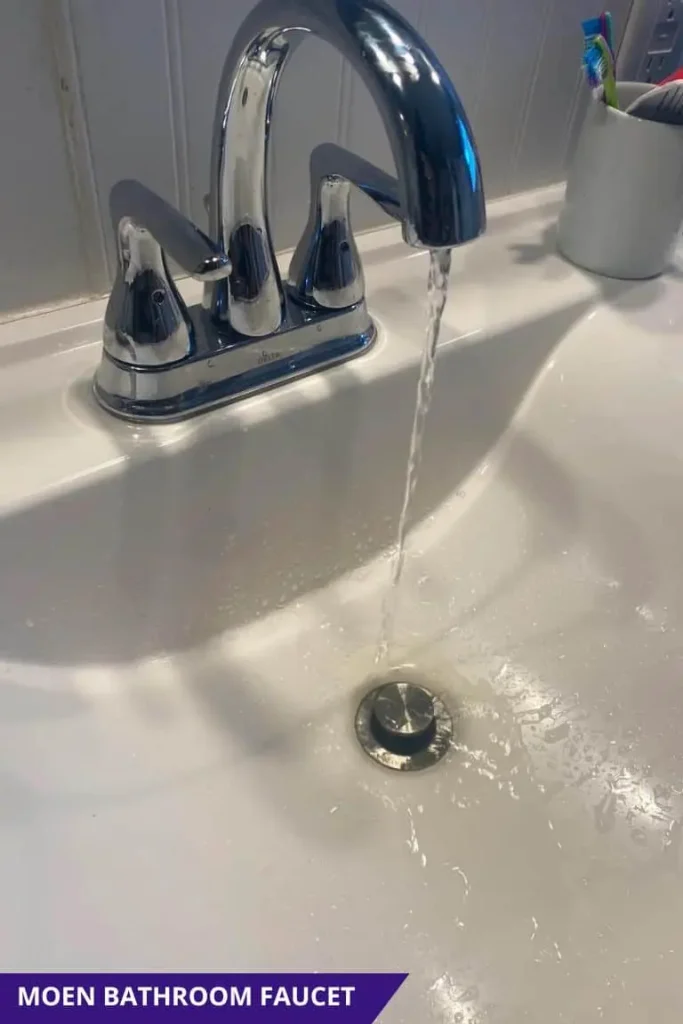
Check the Water Supply Valves
One of the first things to check when you notice low water pressure is whether the water supply valves are fully open. These valves control the flow of water to your faucet, and even a partially closed valve can restrict water pressure.
How to Check the Water Supply Valves:
- Locate the shut-off valves under the sink, usually found on the hot and cold water lines leading to the faucet.
- Turn both valves counterclockwise to ensure they are fully open.
- Test the faucet to see if the water pressure improves.
Additional Notes:
- If opening the valves does not improve the pressure, proceed with the next troubleshooting steps.
- In rare cases, a damaged valve may need replacement. If you suspect the valve is faulty, consider replacing it or consulting a professional plumber.
Clean the Aerator
The aerator is a small mesh screen located at the tip of the faucet. Over time, aerators can become clogged with mineral deposits, reducing water flow. Cleaning the aerator is a quick and easy fix for restoring proper water pressure.
Steps to Clean the Aerator:
- Remove the aerator: Use your hand to unscrew the aerator counterclockwise. If it’s stuck, use pliers wrapped in a soft cloth to avoid damaging the faucet.
- Inspect for debris: Check the aerator for visible mineral deposits, dirt, or debris.
- Soak in vinegar: Soak the aerator in a solution of white vinegar for 30 minutes to dissolve any buildup.
- Brush and rinse: After soaking, use a soft brush to clean the aerator thoroughly. Rinse it with water.
- Reinstall the aerator: Screw the cleaned aerator back onto the faucet, ensuring it’s snug but not overly tight.
Test the faucet to see if the water pressure has returned to normal. If not, continue to the next step.
Recommended: 1950s Bathtub Faucet Repair
Inspect the Cartridge for Blockages
The cartridge inside your Moen faucet controls water flow and temperature. If it becomes clogged or worn out, it can lead to reduced water pressure. Cleaning or replacing the cartridge can solve the issue.
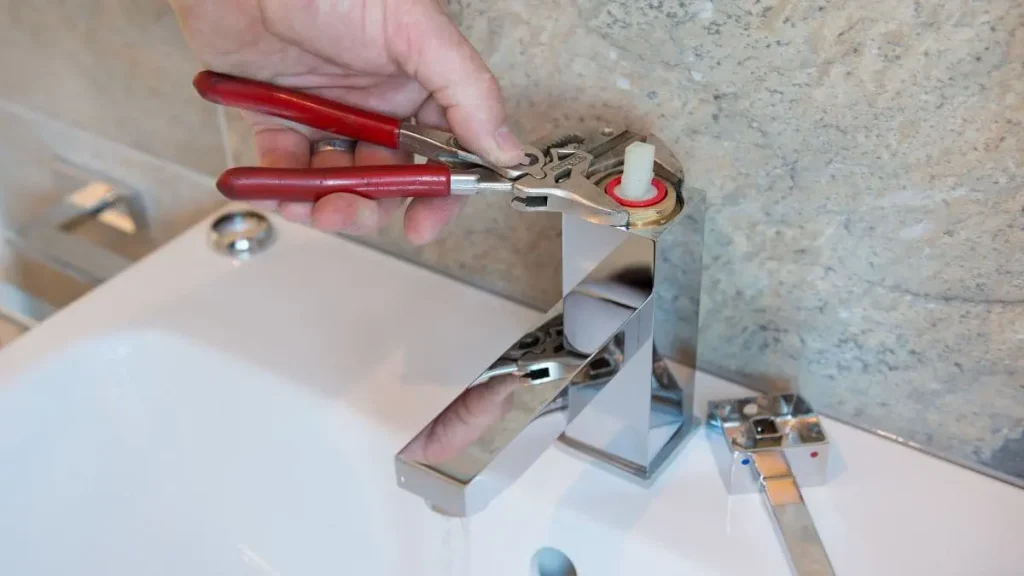
How to Inspect and Clean the Cartridge:
- Turn off the water supply: Before starting, shut off the water valves under the sink to prevent leaks.
- Remove the faucet handle: Use an Allen wrench to loosen the set screw and remove the handle.
- Access the cartridge: Depending on your faucet model, you may need to remove additional screws or caps to expose the cartridge.
- Remove the cartridge: Use pliers to gently pull the cartridge out of the faucet.
- Inspect and clean: Check for any debris or mineral deposits on the cartridge. Soak it in vinegar or a descaling solution, then scrub it gently.
- Reinstall or replace: If the cartridge is worn or damaged, replace it with a new one. If it looks fine after cleaning, reinstall it by reversing the steps.
After reassembly, turn the water supply back on and test the faucet. A clean or new cartridge should restore full water pressure.
Check for Leaks in the Faucet or Pipes
Leaks in the faucet itself or the plumbing underneath can cause a drop in water pressure. These leaks may be due to worn-out seals, damaged O-rings, or loose connections.
Steps to Check for Leaks:
- Inspect visible connections: Check the connections between the faucet and the water supply lines. Tighten any loose nuts or fittings with an adjustable wrench.
- Look for water damage: Check for signs of water leaks under the sink, such as puddles or water stains. These could indicate a leak in the pipes or connections.
- Check the faucet seals: If the faucet leaks from the spout or base, the internal seals or O-rings may be damaged. Replacing these parts may restore proper pressure.
If you cannot locate or fix the leak, consider calling a professional plumber for further assistance.
Flush the Water Lines
Sediment or debris buildup in the water lines can also reduce water pressure. Flushing the water lines clears out blockages and restores proper water flow.
How to Flush the Water Lines:
- Turn off the water supply: Shut off the water supply valves under the sink.
- Disconnect the water supply lines: Use an adjustable wrench to loosen the nuts connecting the supply lines to the faucet.
- Flush the lines: Direct the water supply lines into a bucket or container. Turn on the water supply valves for a few seconds to flush out any debris or sediment.
- Reconnect the supply lines: Reattach the water supply lines to the faucet and tighten the nuts.
After flushing, test the faucet to see if the water pressure has improved. If the problem persists, there may be a more serious blockage in the pipes, and you may need to contact a plumber.
Verify the Home’s Water Pressure
In some cases, the problem may not be with the faucet itself, but rather with the overall water pressure in your home. A low water pressure issue could be caused by problems with your home’s main water supply or plumbing system.
Steps to Check Your Home’s Water Pressure:
- Test the water pressure at other fixtures: Turn on other faucets in your home to see if the issue is isolated to the bathroom faucet or affects the entire house.
- Use a water pressure gauge: Attach a water pressure gauge to an outdoor spigot or another accessible faucet. A reading between 40 to 60 psi is considered normal for residential water pressure.
- Contact your water supplier: If your home’s water pressure is consistently low, there may be an issue with the municipal water supply. Contact your water provider for assistance.
If you confirm that the low water pressure is not limited to your Moen faucet but affects the entire home, professional help may be necessary to identify and fix the larger plumbing issue.
If you’ve recently replaced your water heater and are now experiencing low water pressure in your kitchen sink, it could be related to the installation process or sediment buildup. Learn more about how to troubleshoot low water pressure in kitchen sinks after replacing the water heater in our detailed guide.
Maintenance Tips to Prevent Future Water Pressure Issues
To keep your Moen bathroom faucet functioning properly and avoid water pressure issues in the future, regular maintenance is essential.
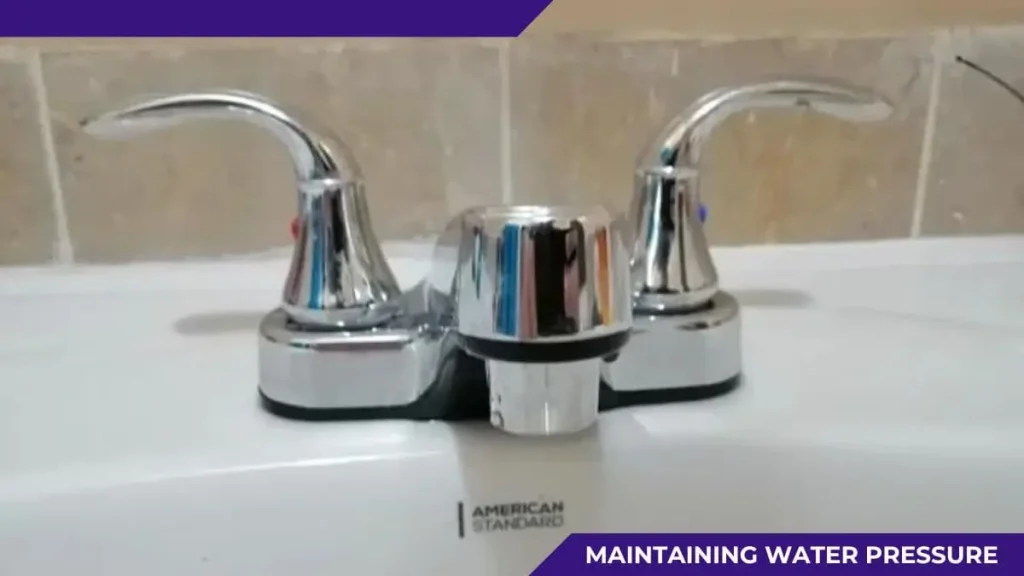
Regularly Clean the Aerator
The aerator is one of the most common components that can become clogged with mineral deposits over time. Routine cleaning of the aerator will help maintain good water flow and prevent pressure problems from arising.
It’s a good practice to clean the aerator every few months, especially if you live in an area with hard water. Hard water contains high levels of minerals, such as calcium and magnesium, which can quickly accumulate on the screen of the aerator.
To clean the aerator, unscrew it from the faucet, soak it in a solution of white vinegar for about 30 minutes to dissolve any buildup, and then use a soft brush to scrub away the remaining debris. After cleaning, reinstall the aerator and test the faucet to ensure smooth water flow.
Flush Water Lines Annually
Flushing the water lines is another important step in maintaining your Moen faucet’s performance. Over time, sediment and debris can build up in the water lines, reducing the flow of water and affecting pressure. Conducting an annual flush of the water lines can help prevent blockages that lead to low water pressure.
To flush the water lines, you need to shut off the water supply to the faucet, disconnect the supply lines, and allow water to run through them into a bucket to clear out any sediment. Once flushed, reconnect the lines and turn the water back on. This process ensures that any debris within the lines is cleared, which helps keep your faucet running at optimal pressure.
Inspect and Replace Seals and O-Rings
The internal seals and O-rings within the faucet are essential components that prevent leaks and ensure smooth operation. However, these parts can wear out over time, leading to reduced water pressure or even leaks.
Performing periodic inspections of the seals and O-rings, especially around the faucet handle and spout, will help identify wear and tear before it causes a problem. If you notice that the seals appear cracked, damaged, or worn, it’s best to replace them as soon as possible.
Replacing these small but vital parts is relatively easy and can significantly improve the faucet’s performance. By keeping the seals and O-rings in good condition, you can prevent leaks and avoid the pressure loss that often accompanies them.
Check the Cartridge for Wear and Tear
The cartridge inside your Moen faucet is responsible for controlling water flow and temperature. Over time, the cartridge can become clogged with debris or experience wear and tear, which may result in low water pressure or inconsistent water temperature.
Routine checks of the cartridge, especially after you’ve experienced water pressure issues, will help keep your faucet working efficiently. If you notice any buildup on the cartridge, you can remove it and clean it by soaking it in a vinegar solution. However, if the cartridge appears to be significantly worn or damaged, replacing it is the best solution.
Moen cartridges are typically easy to find and replace, making this a simple maintenance task that can prevent future water pressure problems. Keeping the cartridge in good condition also ensures smoother water flow and prolongs the faucet’s lifespan.
Prevent Mineral Buildup with a Water Softener
In areas with hard water, mineral buildup can occur not only in the aerator but throughout the faucet and the plumbing system. Installing a water softener is an effective long-term solution to minimize the impact of hard water on your faucet.
A water softener works by removing excess minerals from your water, preventing them from building up in your fixtures and pipes. By reducing mineral deposits, a water softener helps maintain consistent water pressure, reduces the need for frequent aerator cleanings, and extends the life of your faucet.
For homeowners dealing with persistent mineral buildup, this investment can pay off in fewer plumbing problems and a more reliable water flow throughout the home.
Monitor Home Water Pressure
It’s essential to keep an eye on your home’s overall water pressure. Fluctuations in the water pressure coming from the main supply can affect all the faucets and fixtures in your home, including your Moen bathroom faucet.
A pressure gauge can be installed on an outdoor spigot or another accessible faucet to help you regularly monitor the water pressure in your home. If you notice a consistent drop in pressure throughout the house, it may indicate a larger issue with the plumbing system or the municipal water supply.
Schedule Professional Plumbing Inspections
While DIY maintenance can solve many water pressure issues, scheduling professional plumbing inspections every few years is a proactive way to catch problems that may not be visible. A licensed plumber can inspect your entire plumbing system, including your bathroom faucets, water lines, and shut-off valves.
A plumber will be able to identify early signs of wear, leaks, or blockages and provide professional solutions to ensure your home’s plumbing remains in top condition. These inspections are especially important if you live in an older home with aging pipes, as they help prevent more serious issues that could affect water pressure or lead to costly repairs.
Conclusion
Low water pressure in a Moen bathroom faucet can be frustrating, but it is often caused by easily identifiable and fixable issues. By understanding the common reasons behind reduced water flow, such as clogged aerators, worn cartridges, or sediment buildup in water lines, you can troubleshoot and resolve many problems on your own. Regular maintenance, including cleaning the aerator, flushing water lines, and inspecting seals, helps prevent future pressure issues and extends the life of your faucet.
However, when more complex problems arise, or if DIY solutions don’t fully restore water pressure, it may be time to consult a professional plumber. Whether you’re tackling the issue yourself or considering expert help, addressing low water pressure promptly will ensure your Moen faucet continues to function effectively and provide reliable water flow.
You May Also Like:

